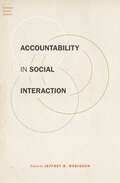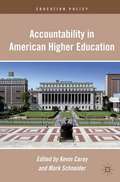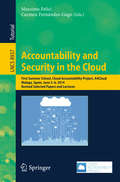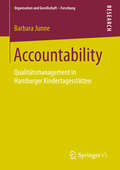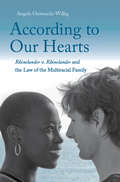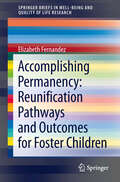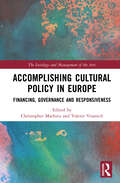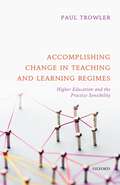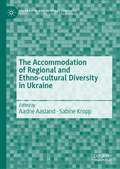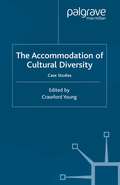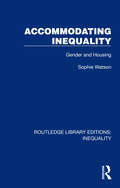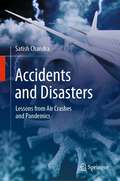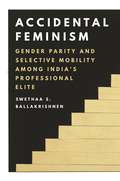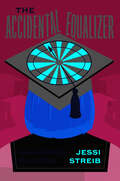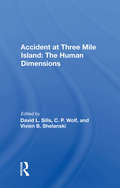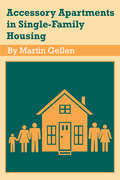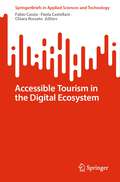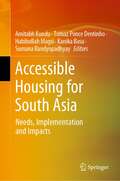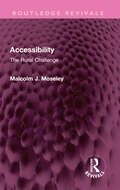- Table View
- List View
Accountability in Social Interaction (Foundations of Human Interaction)
by Jeffrey D. RobinsonWithin the study of language and social interaction, the concept of 'accountability'-including related concepts, such as 'account' or 'motive,' 'accounting,' and 'being accountable'-has been of longstanding interest in terms of how interactants in both ordinary and organizational contexts manage their image or reputation, as well as how they achieve mutual understanding. However, these concepts are polysemous, with different senses being rather dramatic, such as accountability as 'moral responsibility' and accountability as 'intelligibility.' Even today this fact is not always remembered or fully recognized or appreciated by scholars, which has arguably slowed the development of these concepts. This volume brings together a collection of novel, conversation-analytic studies addressing accountability, with the goal of re-exposing its multiple senses, reiterating their interrelationships and, in doing so, breaking new conceptual ground and exposing new pathways for future research. The collection considers central theoretical issues, including turn taking, sequence and preference organization, repair, membership categorization, action formation and ascription, social solidarity and affiliation, and the relevance of context. Chapters range contextually, canvasing interactions between friends and family members, and during talk shows, broadcast news interviews, airline reservations, and medical visits. Chapters also range culturally, including English, Japanese, and Korean data.
Accountability in American Higher Education (Education Policy)
by Kevin Carey & Mark SchneiderIn Accountability in American Higher Education prominent academics, entrepreneurs, and journalists assess the obstacles to, and potential opportunities for, accountability in higher education in America. Providing analysis that can be used to engage institutions of higher education in the difficult but necessary conversation of accountability.
Accountability and Security in the Cloud: First Summer School, Cloud Accountability Project, A4Cloud, Malaga, Spain, June 2-6, 2014, Revised Selected Papers and Lectures (Lecture Notes in Computer Science #8937)
by Massimo Felici Carmen Fernández-GagoThe First A4Cloud Summer School has been one of the first events in the area of accountability and security in the cloud. It was organized by the EU-funded A4Cloud project, in collaboration with the European projects CIRRUS, Coco Cloud, CUMULUS, and SPECS. Cloud computing is a key technology that is being adopted progressively by companies and users across different application domains and industries. Yet, there are emerging issues such as security, privacy, and data protection. The 13 contributions included in this volume cover the state of the art and provide research insights into the following topics: accountability in the cloud; privacy and transparency in the cloud; empirical approaches for the cloud; socio-legal aspects of the cloud; cloud standards; and the accountability glossary of terms and definitions.
Accountability: Qualitätsmanagement in Hamburger Kindertagesstätten (Organisation und Gesellschaft - Forschung)
by Barbara JunneBarbara Junne befasst sich mit der Frage, wie Qualitätsmanagement in Hamburger Kitas als eine gesellschaftlich konstruierte Praktik entsteht, die die gegenseitige Rechenschaftslegung, d.h. Accountability, befördert. Vor diesem Hintergrund kann Qualitätsmanagement eben nicht als objektives Instrument betrachtet werden. Es erscheint vielmehr als ein Vehikel für unterschiedliche Interessen, Sinn- und Bedeutungszuschreibungen der am Diskurs beteiligten Akteure, die sich wiederum über die Zeit verändern. Die Gestaltung von Qualitätsverfahren ist somit auf die Mitgestaltung der lokal handelnden Akteure und deren permanente Rekonstruktion von Qualität angewiesen.
According to Our Hearts: Rhinelander v. Rhinelander and the Law of the Multiracial Family
by Angela Onwuachi-WilligThis landmark book looks at what it means to be a multiracial couple in the United States today. According to Our Hearts begins with a look back at a 1925 case in which a two-month marriage ends with a man suing his wife for misrepresentation of her race, and shows how our society has yet to come to terms with interracial marriage. Angela Onwuachi-Willig examines the issue by drawing from a variety of sources, including her own experiences. She argues that housing law, family law, and employment law fail, in important ways, to protect multiracial couples. In a society in which marriage is used to give, withhold, and take away status—in the workplace and elsewhere—she says interracial couples are at a disadvantage, which is only exacerbated by current law.
Accomplishing Permanency: Reunification Pathways and Outcomes for Foster Children (SpringerBriefs in Well-Being and Quality of Life Research)
by Elizabeth FernandezReunification is a primary goal of foster care systems and the most common permanency planning decision. It is defined as the return of children placed in protective care to the home of their birth family and used to describe the act of restoring a child in out-of-home care back to the biological family. Yet reunification decision-making and the process of reintegrating children into birth families remains under researched. This Brief takes a look at family reunification knowledge and research in Australia where there is evidence that most children placed in protective care are eventually reunited with their birth parents. It explores how a knowledge of reunification decision making and outcomes can contribute to strengthening practice and informing policy formulation and program planning in Child Welfare.
Accomplishing Cultural Policy in Europe: Financing, Governance and Responsiveness (The Sociology and Management of the Arts)
by Christopher Mathieu Valerie VisanichThis book investigates the activities undertaken by the variety of actors that contribute to accomplishing cultural policy in Europe. These range from policy formulation and administration at the national and local levels, to artistic and cultural production activities to institutional governance. Arts and culture are an essential component to individual and collective quality of life. States, regions and municipalities increasingly recognize this intrinsic importance, as well as the instrumental values of the arts and culture. This has led to an increased interest in cultural policy, usually focusing on the policy process and policy effects. How cultural policy is accomplished is a matter of correspondingly increased importance, but less researched and understood. This volume shows how accomplishing cultural policy encompasses a vast expanse of activities, all unique but bound together as part of the continuous process of producing publicly subsidized art and culture for social and aesthetic purposes. The chapters also explore a range of thematic tensions that commonly arise in accomplishing cultural policy, such as the commercialization of arts and culture and counter-reactions; the challenges and means of promoting inclusiveness; the politics and effects of funding of the arts and culture; and good governance and vested interests in the arts and culture. Read together, these vivid case studies present a broad and unique picture of the wider and interconnected accomplishing process by expounding on the middle-ground between the policy formulation process and artistic and cultural production. Adding a novel conceptual formulation to studies of cultural policy, this book will appeal to practitioners, scholars and advanced students with interests in the sociology of the arts and culture, arts and culture management, cultural policy and cultural governance.
Accomplishing Cultural Policy in Europe: Financing, Governance and Responsiveness (The Sociology and Management of the Arts)
by Christopher Mathieu Valerie VisanichThis book investigates the activities undertaken by the variety of actors that contribute to accomplishing cultural policy in Europe. These range from policy formulation and administration at the national and local levels, to artistic and cultural production activities to institutional governance. Arts and culture are an essential component to individual and collective quality of life. States, regions and municipalities increasingly recognize this intrinsic importance, as well as the instrumental values of the arts and culture. This has led to an increased interest in cultural policy, usually focusing on the policy process and policy effects. How cultural policy is accomplished is a matter of correspondingly increased importance, but less researched and understood. This volume shows how accomplishing cultural policy encompasses a vast expanse of activities, all unique but bound together as part of the continuous process of producing publicly subsidized art and culture for social and aesthetic purposes. The chapters also explore a range of thematic tensions that commonly arise in accomplishing cultural policy, such as the commercialization of arts and culture and counter-reactions; the challenges and means of promoting inclusiveness; the politics and effects of funding of the arts and culture; and good governance and vested interests in the arts and culture. Read together, these vivid case studies present a broad and unique picture of the wider and interconnected accomplishing process by expounding on the middle-ground between the policy formulation process and artistic and cultural production. Adding a novel conceptual formulation to studies of cultural policy, this book will appeal to practitioners, scholars and advanced students with interests in the sociology of the arts and culture, arts and culture management, cultural policy and cultural governance.
Accomplishing Change in Teaching and Learning Regimes: Higher Education and the Practice Sensibility
by Paul TrowlerThis book offers a new perspective on the professional world of higher education. Using social practice theory, it presents a practice sensibility rooted in concepts which illuminate teaching and learning contexts. The book takes the reader through the social processes occurring within higher education institutions which shape contexts and influence the direction of change. For leaders and managers, educational developers, change agents, and academics, this sensibility will help to identify the successful paths to changes for enhancement and the patterns of policy implementation likely to occur as teaching and learning is enhanced. For researchers of higher education, the practice sensibility offers new possibilities for meaningful research into teaching and learning issues. Teaching and learning regimes are a key focus of the book. As a family of practices performed by a workgroup in higher education over extended periods, they comprise a number of 'moments'; characteristics derived from structural foundations which shape the workgroup's practices and frameworks of meaning. These moments condition how teaching and learning is fundamentally understood, what its aims are thought to be, what is considered 'normal' practice, how individuals see themselves and others, and how power operates within the workgroup. The material context is significant in this, as are the backstories, personal histories, and institutional sagas. This book develops a completely new approach to Trowler's concept of teaching and learning regimes. Using both his research and that of others in the field, it presents a more nuanced, fully-developed, and sophisticated version of the concept which has great traction for empirical research, the management of change, and the enhancement of the student experience and learning outcomes.
Accomplishing Change in Teaching and Learning Regimes: Higher Education and the Practice Sensibility
by Paul TrowlerThis book offers a new perspective on the professional world of higher education. Using social practice theory, it presents a practice sensibility rooted in concepts which illuminate teaching and learning contexts. The book takes the reader through the social processes occurring within higher education institutions which shape contexts and influence the direction of change. For leaders and managers, educational developers, change agents, and academics, this sensibility will help to identify the successful paths to changes for enhancement and the patterns of policy implementation likely to occur as teaching and learning is enhanced. For researchers of higher education, the practice sensibility offers new possibilities for meaningful research into teaching and learning issues. Teaching and learning regimes are a key focus of the book. As a family of practices performed by a workgroup in higher education over extended periods, they comprise a number of 'moments'; characteristics derived from structural foundations which shape the workgroup's practices and frameworks of meaning. These moments condition how teaching and learning is fundamentally understood, what its aims are thought to be, what is considered 'normal' practice, how individuals see themselves and others, and how power operates within the workgroup. The material context is significant in this, as are the backstories, personal histories, and institutional sagas. This book develops a completely new approach to Trowler's concept of teaching and learning regimes. Using both his research and that of others in the field, it presents a more nuanced, fully-developed, and sophisticated version of the concept which has great traction for empirical research, the management of change, and the enhancement of the student experience and learning outcomes.
The Accommodation of Regional and Ethno-cultural Diversity in Ukraine (Federalism and Internal Conflicts)
by Aadne Aasland Sabine KroppThe book offers new insights into how ethnicity, language and regional-local identity interact within the context of Ukrainian political reform, and indicates how these reforms affect social cohesion among ethno-cultural groups. While the individual chapters each focus on one or a few facets of the overall research question, together they draw a nuanced picture of the multifaceted challenges to creating and consolidating social cohesion in a nationalizing state. The concept integrates various disciplines, including political science, international relations, law, and sociology. Correspondingly, the contributions are based on various methodological approaches, ranging from legal analysis over media discourse analysis, individual and focus group interviews to analysis of data from a representative population survey. The findings of the in-depth study are discussed within the broader context of comparative research on diversity management and social cohesion in fragmented societies.
The Accommodation of Cultural Diversity: Case-Studies
by Crawford YoungThe management of cultural diversity is a major challenge in many states. This book follows up the theoretical analysis of Ethnic Diversity and Public Policy with detailed case studies from leading international experts on Malaysia, Tanzania, Mauritius, Trinidad and Tobago, Northern Ireland, Spain and the United States of America to discover what lessons can be learnt for policy-makers in other divided societies.
Accommodating Inequality: Gender and Housing (Routledge Library Editions: Inequality #9)
by Sophie WatsonOriginally published in 1988, Accommodating Inequality provides a basis for a radical re-think of housing policy and provision in Australia from a gender perspective. It explores the way that housing in Australia helped to produce patriarchal family structures and simultaneously contributed to the dependence of women on men. At the time the book was originally published housing policy at a theoretical or research level was less explored. Issues such as marginalisation, poverty and low income, domestic responsibility are discussed in relation to housing. The book raised new questions and challenged old debates and provides a clear framework within which feminist housing policy can be situated.
Accommodating Inequality: Gender and Housing (Routledge Library Editions: Inequality #9)
by Sophie WatsonOriginally published in 1988, Accommodating Inequality provides a basis for a radical re-think of housing policy and provision in Australia from a gender perspective. It explores the way that housing in Australia helped to produce patriarchal family structures and simultaneously contributed to the dependence of women on men. At the time the book was originally published housing policy at a theoretical or research level was less explored. Issues such as marginalisation, poverty and low income, domestic responsibility are discussed in relation to housing. The book raised new questions and challenged old debates and provides a clear framework within which feminist housing policy can be situated.
Accidents and Disasters: Lessons from Air Crashes and Pandemics
by Satish ChandraThis book deals with the contemporary subject of perception of risk and its influence on accidents and disasters. The contents examine the conventional viewpoints on human errors, incubation of errors, complexity and organisational deviance as a cause for accidents. Work of Mary Douglas with regard to risk, Charles Perrow's work on the normal accident theory and Diane Vaughan's theory on normalisation of deviance are examined from a fresh perspective in this book. It also discusses prominent accidents in aviation, space, nuclear energy, automotive and healthcare, using the pandemic and Boeing 737 Max as a backdrop to study accidents and disasters. It further explores the background and similarities to these events and addresses the core issues such as the state of regulation, the worldview of the sociologists, and proposes that mental models of complex systems, avarice and risk for gain as other possibilities for accidents. Using the concept of nudge in behavioural economics and the Elinor Ostrom’s viewpoint on regulating for common good, it suggests a way forward through the High Reliability Organisation Theory (HRO) leading to enhanced risk perception. The book will be of interest to those who would like to understand the need to incorporate risk perception into regulation, engineers and scientists, professionals and policy makers working in the areas of disaster and risk management, technology areas like aviation, nuclear plants, space and healthcare, students of the sociology of risk and of course the general reader.
Accidental Feminism: Gender Parity and Selective Mobility among India’s Professional Elite
by Swethaa S. BallakrishnenExploring the unintentional production of seemingly feminist outcomes In India, elite law firms offer a surprising oasis for women within a hostile, predominantly male industry. Less than 10 percent of the country’s lawyers are female, but women in the most prestigious firms are significantly represented both at entry and partnership. Elite workspaces are notorious for being unfriendly to new actors, so what allows for aberration in certain workspaces?Drawing from observations and interviews with more than 130 elite professionals, Accidental Feminism examines how a range of underlying mechanisms—gendered socialization and essentialism, family structures and dynamics, and firm and regulatory histories—afford certain professionals egalitarian outcomes that are not available to their local and global peers. Juxtaposing findings on the legal profession with those on elite consulting firms, Swethaa Ballakrishnen reveals that parity arises not from a commitment to create feminist organizations, but from structural factors that incidentally come together to do gender differently. Simultaneously, their research offers notes of caution: while conditional convergence may create equality in ways that more targeted endeavors fail to achieve, “accidental” developments are hard to replicate, and are, in this case, buttressed by embedded inequalities. Ballakrishnen examines whether gender parity produced without institutional sanction should still be considered feminist.In offering new ways to think about equality movements and outcomes, Accidental Feminism forces readers to critically consider the work of intention in progress narratives.
The Accidental Equalizer: How Luck Determines Pay after College
by Jessi StreibA startling discovery—that job market success after college is largely random—forces a reappraisal of education, opportunity, and the American dream. As a gateway to economic opportunity, a college degree is viewed by many as America’s great equalizer. And it’s true: wealthier, more connected, and seemingly better-qualified students earn exactly the same pay as their less privileged peers. Yet, the reasons why may have little to do with bootstraps or self-improvement—it might just be dumb luck. That’s what sociologist Jessi Streib proposes in The Accidental Equalizer, a conclusion she reaches after interviewing dozens of hiring agents and job-seeking graduates. Streib finds that luck shapes the hiring process from start to finish in a way that limits class privilege in the job market. Employers hide information about how to get ahead and force students to guess which jobs pay the most and how best to obtain them. Without clear routes to success, graduates from all class backgrounds face the same odds at high pay. The Accidental Equalizer is a frank appraisal of how this “luckocracy” works and its implications for the future of higher education and the middle class. Although this system is far from eliminating American inequality, Streib shows that it may just be the best opportunity structure we have—for better and for worse.
The Accidental Equalizer: How Luck Determines Pay after College
by Jessi StreibA startling discovery—that job market success after college is largely random—forces a reappraisal of education, opportunity, and the American dream. As a gateway to economic opportunity, a college degree is viewed by many as America’s great equalizer. And it’s true: wealthier, more connected, and seemingly better-qualified students earn exactly the same pay as their less privileged peers. Yet, the reasons why may have little to do with bootstraps or self-improvement—it might just be dumb luck. That’s what sociologist Jessi Streib proposes in The Accidental Equalizer, a conclusion she reaches after interviewing dozens of hiring agents and job-seeking graduates. Streib finds that luck shapes the hiring process from start to finish in a way that limits class privilege in the job market. Employers hide information about how to get ahead and force students to guess which jobs pay the most and how best to obtain them. Without clear routes to success, graduates from all class backgrounds face the same odds at high pay. The Accidental Equalizer is a frank appraisal of how this “luckocracy” works and its implications for the future of higher education and the middle class. Although this system is far from eliminating American inequality, Streib shows that it may just be the best opportunity structure we have—for better and for worse.
Accident At Three Mile Island: The Human Dimensions
by David L. SillsThe nuclear accident at Three Mile Island in March 1979 was as much a social-systems failure as it was an engineering failure. It raised questions not only about the regulation and management of nuclear-power plants but also about the effects of nuclear accidents on the community, on society, and on the total controversy surrounding nuclear energy. Questions were also raised about public perceptions of the risks of high technology. At the request of the President's Commission on the Accident at Three Mile Island (the Kemeny Commission), the Social Science Research Council commissioned social scientists to write a series of papers on the human dimensions of the event. This volume includes those papers, in revised and expanded form, and a comprehensive bibliography of published and unpublished social science research on the accident and its aftermath.
Accident At Three Mile Island: The Human Dimensions
by David L. Sills C. P. Wolf Vivien B. ShelanskiThe nuclear accident at Three Mile Island in March 1979 was as much a social-systems failure as it was an engineering failure. It raised questions not only about the regulation and management of nuclear-power plants but also about the effects of nuclear accidents on the community, on society, and on the total controversy surrounding nuclear energy. Questions were also raised about public perceptions of the risks of high technology. At the request of the President's Commission on the Accident at Three Mile Island (the Kemeny Commission), the Social Science Research Council commissioned social scientists to write a series of papers on the human dimensions of the event. This volume includes those papers, in revised and expanded form, and a comprehensive bibliography of published and unpublished social science research on the accident and its aftermath.
Accessory Apartments in Single-family Housing
by Martin GellenAs the reproduction cost of housing has increased, consumers have made intensive use of existing dwellings. Conversions of the housing stock have regained prominence as a source of supply. This book introduces the accessory apartment and assesses its potential as an emerging resource for meeting local and national housing needs. Although accessory apartments help meet some of the nation's housing needs, they are not entirely without problems. Some of these are environmental problems, such as physical alterations that are out of character with the design and appearance of surrounding structures, while other problems are cultural and ideological. The accessory apartment in a single-family house deviates from the image of housing, family, and neighborhood that prevails in American culture. It symbolizes a change in the way the single-family house is used and the kinds of people who live in it. These changes clash with the traditional meanings attached to the categories of residential zoning. Martin Gellen evaluates and answers the following questions throughout the text: How do we live with accessory apartments? Control their number? Ensure their soundness?--and maintain neighborhood standards? He focuses on the physical planning problems of conversions and examines the zoning issues they raise. This includes a realistic appraisal of the purposes of density and occupancy controls in exclusive single-family districts. The author provides new methods for regulation of density and occupancy which permit more flexible use of single-family housing to meet the housing needs of a more diverse population. Whether in an aging suburb or new tract, the accessory apartment is a current challenge. This book provides a clear headed approach toward a popular trend in the ever changing housing industry.
Accessory Apartments in Single-family Housing
by Martin GellenAs the reproduction cost of housing has increased, consumers have made intensive use of existing dwellings. Conversions of the housing stock have regained prominence as a source of supply. This book introduces the accessory apartment and assesses its potential as an emerging resource for meeting local and national housing needs. Although accessory apartments help meet some of the nation's housing needs, they are not entirely without problems. Some of these are environmental problems, such as physical alterations that are out of character with the design and appearance of surrounding structures, while other problems are cultural and ideological. The accessory apartment in a single-family house deviates from the image of housing, family, and neighborhood that prevails in American culture. It symbolizes a change in the way the single-family house is used and the kinds of people who live in it. These changes clash with the traditional meanings attached to the categories of residential zoning. Martin Gellen evaluates and answers the following questions throughout the text: How do we live with accessory apartments? Control their number? Ensure their soundness?--and maintain neighborhood standards? He focuses on the physical planning problems of conversions and examines the zoning issues they raise. This includes a realistic appraisal of the purposes of density and occupancy controls in exclusive single-family districts. The author provides new methods for regulation of density and occupancy which permit more flexible use of single-family housing to meet the housing needs of a more diverse population. Whether in an aging suburb or new tract, the accessory apartment is a current challenge. This book provides a clear headed approach toward a popular trend in the ever changing housing industry.
Accessible Tourism in the Digital Ecosystem (SpringerBriefs in Applied Sciences and Technology)
by Fabio Cassia Paola Castellani Chiara RossatoThis book explores the growing demand for accessible tourism experiences and demonstrates how the perspective of digital ecosystems can play a vital role in creating more inclusive destinations. Through a combination of conceptual arguments and real-world case studies, the book sheds light on the practical aspects of accessible tourism. Statistics reveal that over one billion people have severe or moderate disabilities, emphasizing the urgent need for enhanced accessibility in tourism. However, both industry practices and academic research in this field are still lagging behind. The book highlights the challenge of establishing coordination among various stakeholders, including transport operators, hospitality firms, and public authorities, which has hindered the design and implementation of inclusive tourism experiences. By harnessing the power of new technologies, the book illustrates how digital ecosystems can effectively facilitate accessible tourism. It examines the demand for such experiences and demonstrates how embracing a digital ecosystem perspective can contribute to the development of more accessible tourism destinations. In addition to its theoretical insights, the book delves into several practical case studies that showcase successful examples of accessible tourism.
Accessible Housing for South Asia: Needs, Implementation and Impacts
by Amitabh Kundu Tomaz Ponce Dentinho Habibullah Magsi Kanika Basu Sumana BandyopadhyayThis book deals with important issues related to urban housing in South Asia. It analyses various aspects of housing, including spatial and temporal requirements and needs, as well as the challenges of implementing housing projects, such as financial feasibility of estate development projects and housing design. Finally, it discusses the socio-economic and environmental impacts of the rapid urban housing development in South Asia. Written by experts from various disciplines, the book presents several case studies that address issues such as housing provision; legislative, financial and technical support; access to employment opportunities and markets; the cumulative impact on gentrification; exclusion and spatial equity; and the economic, social and environmental sustainability of urban tissue. Researchers, housing planners, and policy makers will find this book a valuable resource in meeting the demand for affordable and sustainable housing and overcoming housing shortages in developing countries
Accessibility: The Rural Challenge (Routledge Revivals)
by Malcolm J. MoseleyOriginally published in 1979, this book discusses the problem faced by planners, county councils, transport, health and education authorities as well as the inhabitants of rural Britain, of the inaccessibility of many areas of the UK. For certain sections of society such as the less well-off, children and teenagers and the elderly the impact is felt most strongly when local shops, schools and medical services are withdrawn in favour of larger units in distant towns. The book reviews the process of decline which led to this situation and considers the concept of accessibility to show how it can be developed into an analytical tool for measuring the success or failure of alternative policies. Each policy option is discussed in detail: the support of conventional bus or other transport services; the provision of mobile services; ‘mini-outlet’ policies and the long-term restructuring of the rural settlement pattern.
